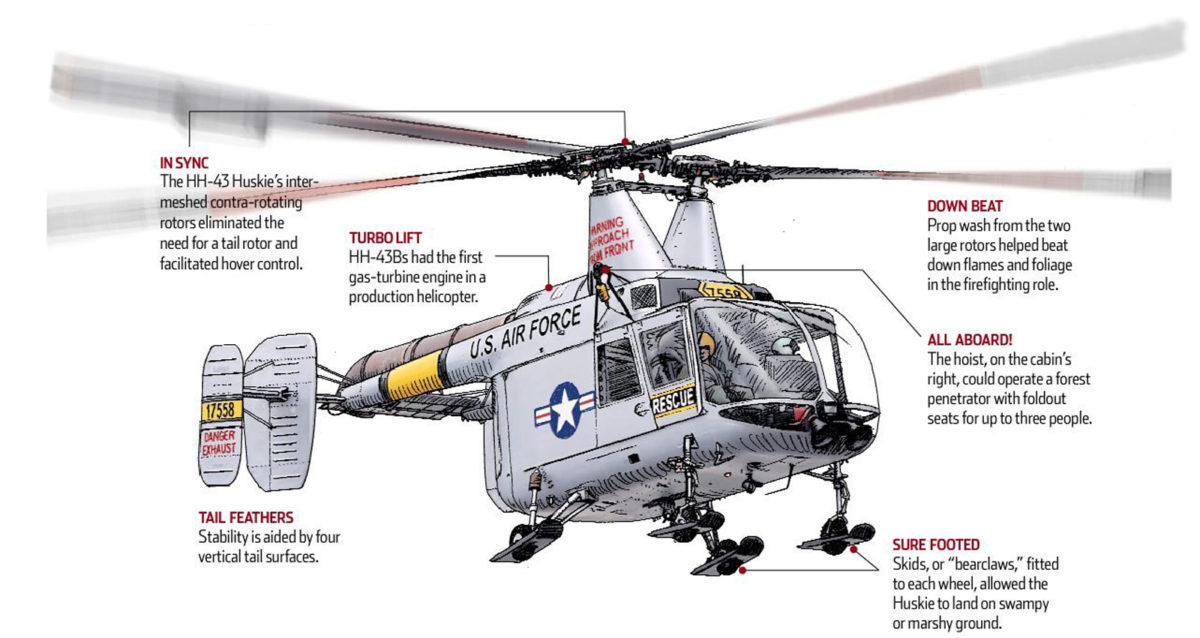HH-43 Facts & Figures
- Crew: 2–3
- Fuselage length: 28 ft. 8 in.
- Rotor diameter: 44 ft 5 in. each, 47 ft. total
- Engines: Lycoming T-53-L-11A, 860 shp
- Max speed: 125 mph/106 kts
- Cruise speed: 105 mph/89 kts
- Max. range: 276 mi./240 nm
- Passengers: 11
Initially designed for U.S. Navy at-sea rescues, the HH-43 had two intermeshed contra-rotating rotors to facilitate hover control and eliminate the need for a tail rotor. The first prototype flew in 1947 with a 690 shaft horsepower (shp) piston engine, but an experimental version with two gas-turbine engines was tested in 1954. The USAF ordered a later version of that prototype equipped with a single 860 shp gas turbine in 1958. The next year, the HH-43B became the first gas-turbine-powered helicopter to enter production.
In March 1964, the U.S. Air Force deployed six Pacific Air Rescue Center HH-43B Huskies to Thailand’s Nakhon Phanom Royal Thai Air Force Base, forming the 33rd Air Rescue Squadron’s forward detachment. A year later, the 33rd launched its first Combat Search and Rescue (CSAR) mission of the Vietnam War. Responding to an F-105D shoot down, an HH-43F Huskie, supported by two USAF A-1E Skyraiders, flew 17 miles north of the DMZ to rescue Captain Robert V. Baird.
The buildup in Vietnam caught the Air Force with few SAR squadrons and no SAR platforms designed for the missions required. The HH-43B lacked armor and armament because the Air Force had envisioned it only for the airborne fire-fighting and air base crash rescue role. The CH-21 was considered the better SAR platform because of its greater range, but its vulnerability to fire surfaced early in the French-Algerian War, forcing a rethinking of SAR mission requirements and platforms. The Vietnam deployment came before the Air Force could select a new helicopter, so the HH-43B was quickly modified for CSAR by adding titanium armor and designated HH-43F. Most HH-43Bs were brought up to “F” standard.
Trained for emergency response, a Huskie crew could be airborne in under a minute. Initially they were unarmed, but early experience led some crewmen to install a Browning automatic rifle or .30-cal. machine gun in a door sling. The crews also scrounged up additional cable for the hoist, since the helo’s standard cable was only 100 feet long, too short for dense canopy rescues.
Neither specifically designed nor particularly suitable for CSAR, the HH-43F flew more air rescues than any other aircraft in the war, though its limitations were problematic as North Vietnamese air defenses improved. As more purpose-built HH-3s arrived, the Huskies were relegated to their original role. The last HH-43 left Indochina on Sept. 20, 1975, making it the first USAF SAR helicopter to conduct a combat search-and-rescue mission and the last to leave the theater.





